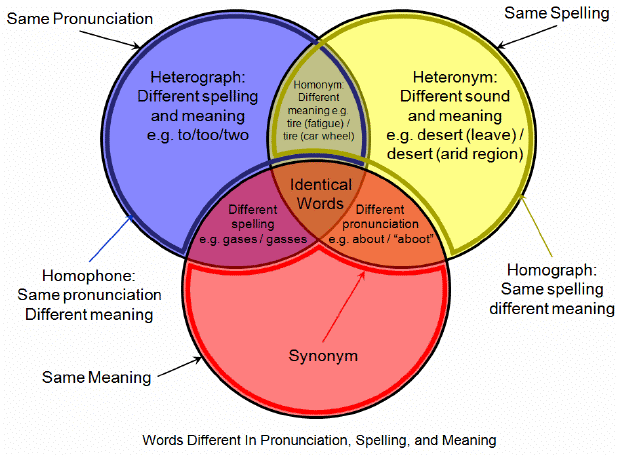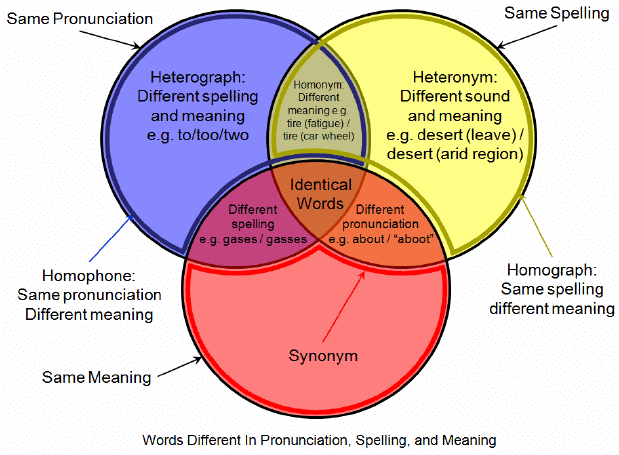
Venn diagram which compares and contrasts heterographs, homophones, homographs, and synonyms. Diagram by Will Heltsley, used by permission under GNU Free Documentation License.
On October 13, 2009, Apple posted a tech bulletin about their new iFrame video format. On that same day, Sanyo sent out a press release about two new Sanyo cameras which support this new homophonic video format. Although I an intrigued by the new format, I am disturbed by their choice of this homophonic, heterographic term, as you will see ahead in this TecnoLinguistic article.
What's a homophone? What's a heterograph?
The term homophone should be familiar to you from your English grammar class in elementary school, but above is a Venn diagram which compares and contrasts heterographs, homographs, homophones, and synonyms.
Examples of homophones in English
- aye/eye/I
- hear/here
- to/too/two
- you're/your
Daniel Goldschlager, an avid reader of ProVideo Coalition magazine, has caught me a few times already when I've mistakenly written your instead of you're…. and thanks to Daniel's constructive criticisms (and digital publication), I have been able to correct it without wasting any ink or paper!
Examples of homophones in Castilian (homófonos)
- aré (preterite tense of arar)/haré (future tense of hacer)
- ay/hay
- a ver/haber
- tubo/tuvo
People seem to be more apt to write a homophone by mistake in their first language than in their 2nd. Daniel Goldschlager has caught me writing your instead of you're, but nobody has ever caught me writing a homophone in Castilian. On the other hand, I receive several e-mails a day from native Castilian speakers, and I see these types of examples constantly. It must be related to the fact that (when we have formal education in a second language), the term is simultaneously recorded in the brain together with the spelling, while when we learn our first language, many terms are first engrained in the brain without the associated spelling as we first hear them as children.
Why am I so disturbed that Apple & Sanyo are calling it iFrame?
- The term IFRAME has already been used by web designers in HTML coding: < iframe >…< /iframe > (without the blank spaces in either example).
- The term I-frame has already been used as a descriptive term to describe certain types of video compression formats. [See my article When to edit native, When hybrid, When pure i-frame, and Why from November 3, 2008 for more information about that use of the term.]
- From the little data published so far, there is no indication whatsoever that the iFrame format even uses I-frame encoding!
So far, we know that the iFrame format uses H.264 compression for video and AAC (MPEG4) for audio, using progressive 960×540 pixels. This resolution may sound familiar. If so, it's because of the fact that many recent Panasonic cameras (150, 151, 170, 200) have used sensors whose native resolution is 960×540 (before being converted to 1920×1080 via spatial offset or what I call “video alchemy”). This resolution is also the maximum spatial resolution of the current AppleTV when your temporal resolution is over 25p. [See my article AppleTV, WDTV, or Blu-ray: Which one is best to distribute your HD project? from November 20, 2008 for more info about that.]
Although neither Apple nor Sanyo has yet stated whether the new iFrame format uses i-frame or long-GOP encoding, Apple has stated that starting with iMovie '09 version 8.05, this is a natively-rendered format. (Most consumer and professional H.264-based cameras use long-GOP encoding, but Panasonic's AVC-intra is i-frame.)
I can imagine the questions flowing in:
“Allan, how can I webstream iFrame video I shot with my Sanyo camera after I convert it to i-frame, and then have my friend put that stream into an IFRAME on her website?”
For more information about this new homophonic format, check out Apple's tech note, Larry Jordan's blog, and Sanyo's press release.
Allan Tépper's articles and seminars
Get a full index of Allan Tépper's articles and upcoming seminars at AllanTepper.com. Listen to his podcast TecnoTur, together with Tanya Castañeda, Rub©n Abruña, and Liliana Marín, free via iTunes or at TecnoTur.us.

Filmtools
Filmmakers go-to destination for pre-production, production & post production equipment!
Shop Now












